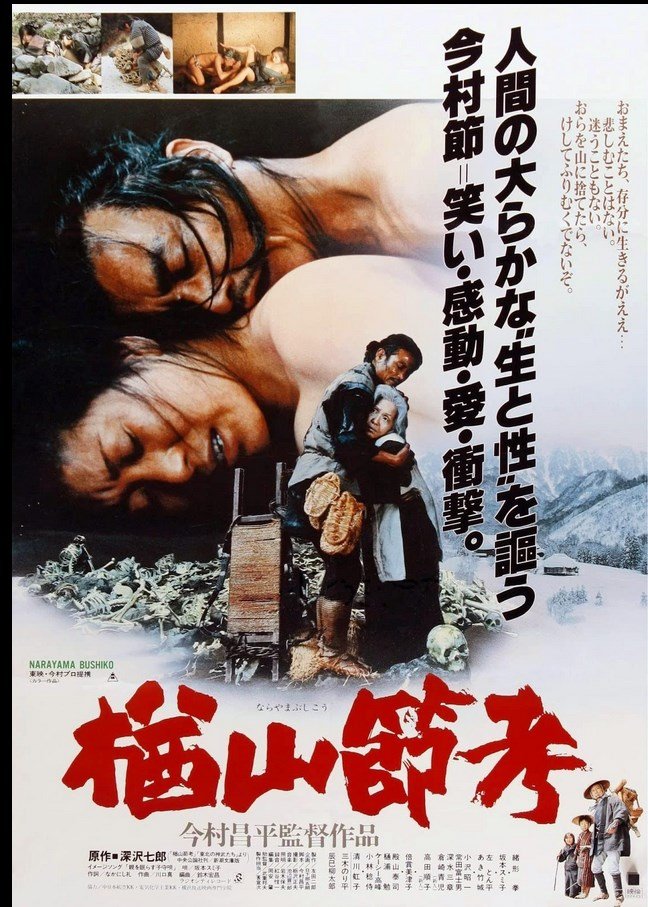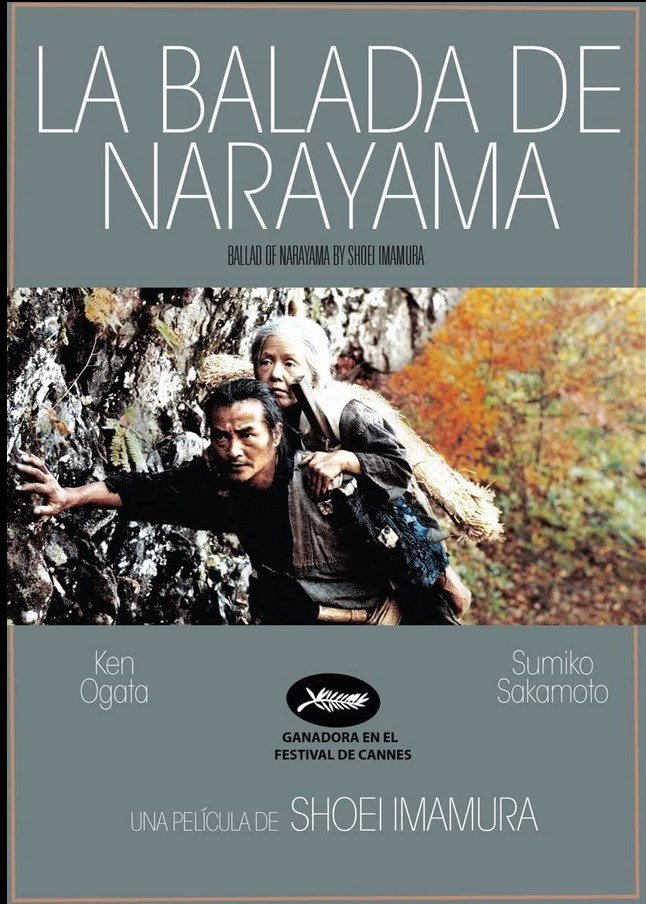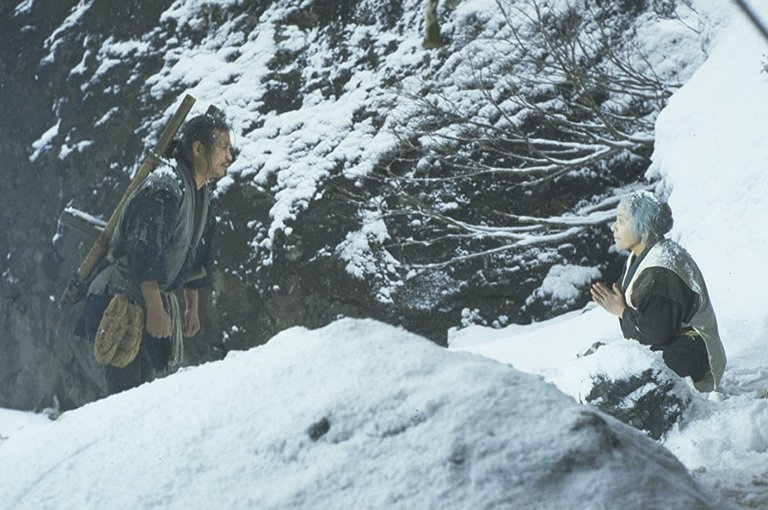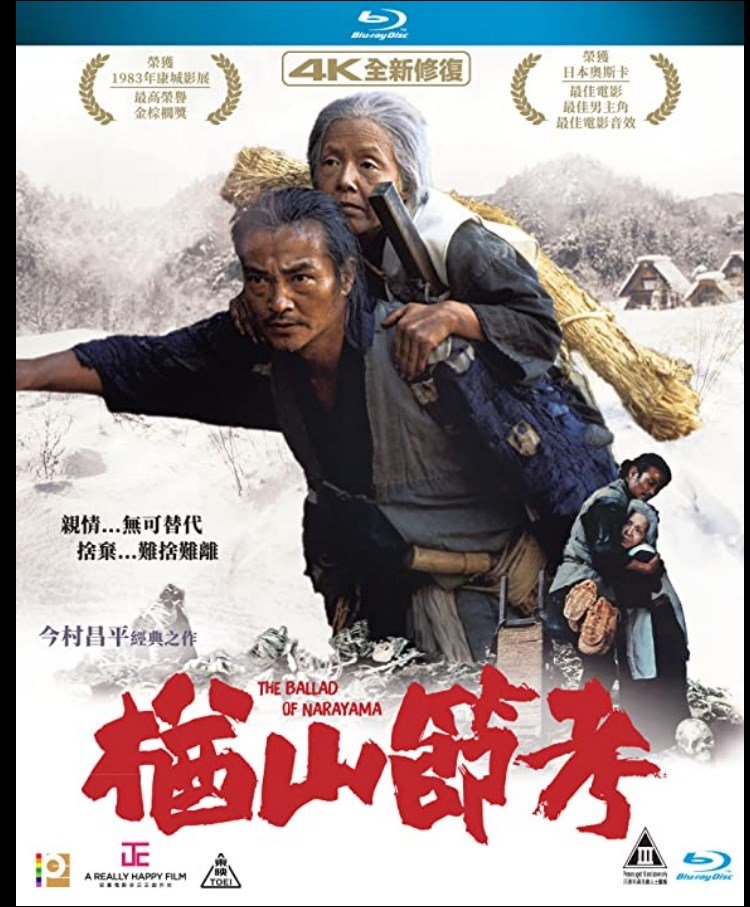[ENG/ESP] The Ballad of Narayama is a film that shows the moral degradation of a rural, archaic and primitive Japan. / La Balada de Narayama es una película que muestra la degradación moral de un Japón rural, arcaico y primitivo.

Winner of the Palme d'Or at the 1984 Cannes Film Festival, this film, directed by Shōhei Imamura a year earlier, is actually a remake of The Legend of Narayama, directed by Keisuke Kinoshita in 1958, and is also based on a series of short stories by the writer Fukazawa Shichirō, perhaps one of the most talented Japanese writers of the last century.

Ganadora de la Palma de Oro en el Festival de Cannes de 1984 esta película dirigida por Shōhei Imamura un año antes, es en realidad un remake de La leyenda de Narayama, dirigida por Keisuke Kinoshita, en 1958, y está también basada en la serie de relatos del escritor Fukazawa Shichirō, tal uno de los más talentosos escritores japones del siglo pasado.

The film is set in a rural, archaic and primitive Japan that fails to keep pace with modern society.
When the elderly reach a certain age, they are escorted to Mount Narayama to be left to die and leave their place to a younger person so that they can survive, due to the food shortage.
A village where people do not eat every day and where the most aberrant practices such as infanticide, incest, schizophrenia, lynching and esoteric rites are common practices accepted by the rest of society.

La película se ambienta en un Japón rural, arcaico y primitivo que no logra estar al paso con la sociedad moderna.
Cuando los ancianos llegan a una cierta edad son acompañados al monte Narayama para dejarse morir y dejar su lugar a uno más joven para que pueda sobrevivir, debido la carestía de alimentos.
Un pueblo donde no se come todos los días y donde las prácticas más aberrantes como el infanticidio, el incesto, la esquizofrenia, el linchaje y los ritos esotéricos son prácticas comunes aceptadas por el resto de la sociedad.


Imamura's film, set at the end of the 19th century (1860) in a Japan that retains certain remnants of the feudal society of the time, stands out for the extreme coldness and rigidity with which it narrates a year in the life of a village, as presumably there were many in Japan at the time.
An anthropological look, as if it were a scientific study by the director, stripped of any lyricism or humanity, at a society that was still very backward, even though it was on the threshold of the modern era.
A society in which famine is commonplace, with an economy based on subsistence agriculture and governed by laws that seem to belong more to the wild world of nature than to that of human civilisation.
In the village of Shinshu there is an unwritten law, but still with the force of years of application, that forces people who reach the age of seventy to go to the mountain of Narayam to let themselves die in order to leave their place to a younger person, giving him or her the possibility of eating and surviving.
However, sometimes it is a matter of evading this real commandment. This is the case of Orin, a 69 year old woman who must leave the village next year to go to the mountain of death.
However, faced with the imminence of her departure, she does everything she can to help her family survive. Starting with his eldest son Tatsuhei, a widower who wishes to remarry. And Risuke, his second son, so that he can finally sleep with a woman.
When everything is ready for departure, he climbs onto his eldest son's shoulders and sets off for Narayama. His time has come. Orin breaks his front teeth as a symbolic act foreshadowing his future departure.
When they reach the mountain, they discover that the place is littered with the human remains of others who, like her, have come there to die.
Finally, when all is ready, Orin breaks her front teeth as a symbolic act foreshadowing her future departure, and leaves the village on her own.
Finally sitting on a rock, she waits for her moment, at which point it begins to snow.


La película de Imamura que se ubica hacia fines del siglo XIX (1860) en un Japón que conserva ciertos resabios de la sociedad feudal de un tiempo, se destaca por la extrema frialdad y rigidez con la que narra un año en la vida de un pueblo, como presumiblemente había muchos en Japón en esa época.
Una mirada antropológica, como si fuera un estudio científico del director despojado de todo lirismo o humanidad, sobre una sociedad todavía muy atrasada, aunque se encuentra las puertas de la era moderna.
Una sociedad en la cuál la hambruna es moneda corriente, con una economía basada en la agricultura de subsistencia y regida por leyes que parecen pertenecer más al mundo salvaje de la naturaleza que al de la civilización humana.
En la aldea de Shinshu hay una ley no escrita pero igual con la fuerza de años de aplicación, que obliga a las personas que cumplen setenta años a ir a la montaña de Narayam a dejarse morir para dejarle el puesto a otra persona más joven dándole la posibilidad de comer y sobrevivir.
Sin embargo a veces se trata de eludir este verdadero comandamiento. Es el caso de Orin, una anciana de 69 años que al año entrante debe dejar la aldea para encaminarse hacia la montaña de la muerte.
Sin embargo, ante la inminencia de la partida, trabaj todo lo que puede para que su familia logre sobrevivir. Comenzando por su hijo mayor Tatsuhei, viudo que desea volver a casarse. Y de e Risuke, su segundo hijo, para que por fin pueda acostarse con una mujer.
Cuando todo está listo para la partida se sube a los hombros de su hijo mayor y se encamina hacia Narayama. Su momento ha llegado. Orin se rompe los dientes delanteros como un acto simbólico que presagia su futura partida.
Cuando llegan a la montaña descubren que el lugar se encuentra sembrado de restos humanos de otras personas que, como ella, han llegado hasta allí para morir.
Finalmente, cuando todo está listo, Orin se rompe los dientes delanteros como un acto simbólico que presagia su futura partida, y abandona la aldea a hom
Sentada finalmente en una roca espera su momento, mientras en ese momento comienza a nevar.

Ken Ogata: Tatsuhei
Sumiko Sakamoto: Orin
Aki Takejo: Tamayan
Tonpei Hidari: hermano de Tatsuhei
Seiji Kurasaki: Kesakichi
Kaoru Shimamori - Tomekichi
Ryutaro Tatsumi - Matayan

Palme d'Or at the Cannes Film Festival in 1983.
Palma de oro del Festival de Cine de Cannes en 1983.

In a primitive society that is harsh and stark, hypocritical, cruel, carnal and blasphemous, in which, in the midst of the protagonists who are wallowing in the mud, rises the emblematic figure of the old woman who goes beyond love and hate, defying the laws of nature and of the very society she is part of, to end up bowing to the dictates of the same.
The ballad of the farewell in which the whole family participates is a dance directed to a dimension superior to human baseness where she is going to go to meet it.

En un sociedad primitiva dura y descarnada, hipócrita, cruel, carnal y blasfema, en la cuál en medio de los protagonistas que se revuelven el fango, se yergue la figura emblemática de la anciana que va más allá del amor y del odio, desafiando a la leyes de la naturaleza y de la misma sociedad que integra, para terminar plegándose a los dictados de la misma.
La balada de la despedida en la cuál participa toda la familia es una danza dirigida a una dimensión superior a las bajezas humanas a la cuál va a ir a su encuentro.


¡Felicitaciones!
Estás participando para optar a la mención especial que se efectuará el domingo 12 de diciembre del 2021 a las 8:00 pm (hora de Venezuela), gracias a la cual el autor del artículo seleccionado recibirá la cantidad de 1 HIVE transferida a su cuenta.
¡También has recibido 1 ENTROKEN! El token del PROYECTO ENTROPÍA impulsado por la plataforma Steem-Engine.
1. Invierte en el PROYECTO ENTROPÍA y recibe ganancias semanalmente. Entra aquí para más información.
2. Contáctanos en Discord: https://discord.gg/hkCjFeb
3. Suscríbete a nuestra COMUNIDAD y apoya al trail de @Entropia y así podrás ganar recompensas de curación de forma automática. Entra aquí para más información sobre nuestro trail.
4. Visita nuestro canal de Youtube.
Atentamente
El equipo de curación del PROYECTO ENTROPÍA